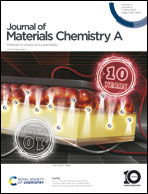Re-investigating the structure–property relationship of the solid electrolytes Li 3−xIn1−xZrxCl6 and the impact of In–Zr(iv) substitution†
Abstract
Chloride-based solid electrolytes are considered interesting candidates for catholytes in all-solid-state batteries due to their high electrochemical stability, which allows the use of high-voltage cathodes without protective coatings. Aliovalent Zr(IV) substitution is a widely applicable strategy to increase the ionic conductivity of Li3M(III)Cl6 solid electrolytes. In this study, we investigate how Zr(IV) substitution affects the structure and ion conduction in Li3−xIn1−xZrxCl6 (0 ≤ x ≤ 0.5). Rietveld refinement using both X-ray and neutron diffraction is used to make a structural model based on two sets of scattering contrasts. AC-impedance measurements and solid-state NMR relaxometry measurements at multiple Larmor frequencies are used to study the Li-ion dynamics. In this manner the diffusion mechanism and its correlation with the structure are explored and compared to previous studies, advancing the understanding of these complex and difficult to characterize materials. It is found that the diffusion in Li3InCl6 is most likely anisotropic considering the crystal structure and two distinct jump processes found by solid-state NMR. Zr-substitution improves ionic conductivity by tuning the charge carrier concentration, accompanied by small changes in the crystal structure which affect ion transport on short timescales, likely reducing the anisotropy.



 Please wait while we load your content...
Please wait while we load your content...